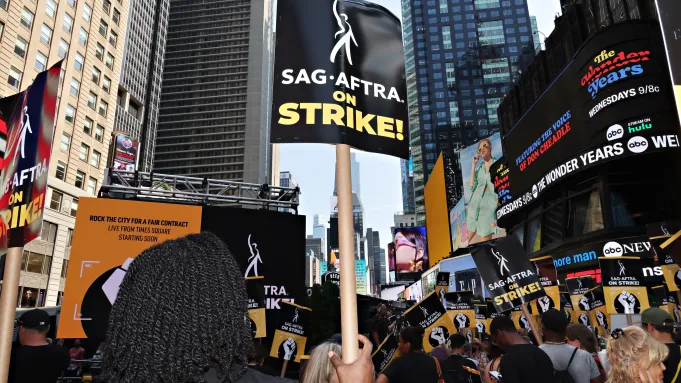Entertainment, Features
Everything We Need to Know about the SAG-AFTRA Strike

On July 13, 2023, the Screen Actors Guild and the American Federation of Television and Radio Artists (SAG-AFTRA) announced their call to strike against the Alliance of Motion Picture and Television Producers (AMPTP) in the fight for better Pension, Health, wages, residuals, and treatment. So far, this fight continues as Sag-Aftra reaches its 45th day picketing on the front steps of Netflix, Disney, and other major companies. In addition, the chief negotiator and national executive secretary, Duncan Crabtree-Ireland, continues to negotiate a 3-year term contractual agreement with the AMPTP in hopes of ending the strike and proceeding with production amidst the upcoming pilot season.
Currently, SAG-AFTRA is at a standstill after detailing its 12-page document outlining its proposal for better wages and fair treatment for actors, dancers, singers, stand-ins, background actors, etc. However, the AMPTP published a counter proposal illustrating SAG-AFTRA’s lack of clarity in the negotiation between the two. We need to know everything about the SAG-AFTRA strike and where the sides divide.
Call for Significant Change
There are a few significant focus areas towards the new 3-year television and theatrical contractual agreements between SAG-AFTRA and the AMPTP. Those objectives include fair wages, proper treatment for performers, pension increases, health care, and overall transparency between performers and production. SAG-AFTRA believes their request is reasonable and appropriate in conjunction with inflation and today’s industry revenue. Crabtree-Ireland addressed his concerns regarding the “current performance streaming model” and how it “undercuts performers’ residual income.” The unfair treatment results in unsustainable living conditions for actors and performers.
AMPTP’s Detailed Response to SAG-AFTRA’s Proposals via Deadline.com
SAG-AFTRA requested an 11% increase in wages for the first contractual year, followed by a 4% increase in the second and a 3.5% increase in the third. The increase would benefit photo-doubles, background actors, stunt coordinatners, etc. However, the Union was unsatisfied with the Alliance’s efforts to reach a substantial agreement because it fell short of their financial demands. The LA Times reports The Alliance’s indication of the Union’s dishonesty in response to SAG-AFTRA by claiming the Union had “walked away” from a deal worth “1 billion wage increases, pensions, and health.” This deal would include a 5% increase in the first year, 4% in the second year, and 3.5 in the third. According to Deadline.com, the last time the Union could “secure a 5%” increase in general wage was in 1988.
The proposal also addresses per diems for performers who travel for work and pay for meals. In addition to payment, it emphasizes the need to pay per diem upfront instead of “weeks down the line.” While AMPTP somewhat consented to an increase in per diem, their advances are far from SAG-AFTRA’s request.
Adequate Compensation
In addition to wages is fair compensation for time. SAG-AFTRA proposes adequate compensation for rehearsals and performances for singers, dancers, and performers. Further, talent should be adequately compensated for doing more than what they were originally hired for. As an example, if dancers are hired to sing in addition to their initial contract and vice versa. Those performing in the same role as the principal, such as stand-ins, would receive half the wage of the principal performer in addition to their original pay.
The AMPTP lowballed each request, offering only a $150 increase for stand-ins for multi-camera half-hour shows and rejected compensation for performers under single-camera shows. The Alliance also rejected a 150% increase in pay for stand-ins hired as background on the same day.
Within the 12-page proposal, many of SAG-AFTRA’s call to action includes fair compensation for background actors, stand-ins, and photo doubles. A background actor receives far less pay than an average wage for a full day’s work of 12 hours or more these days The Union addresses the discrepancies of wages for background actors on the East Coast compared to the West Coast, stating that the wages for New York and Los Angeles Background actors are different and would like to join their contracts for equal pay. AMPTP rejects this proposal.
Self Tape Procedures
However, both parties come to an agreement regarding self-tape procedures. This includes limiting the number of pages in a script to 8 when auditioning and providing a 48-hour window for adults and a 72-hour window for minors to submit audition material. Also, lessening the requirements for a proper self-tape that does not require high-tech equipment, i.e., quality cameras, lights, microphones, and backdrops that can all become costly.
As for pension and health benefits, The Union requests an increase in pension and health caps that have “remained stagnant for more than 40 years.” Despite the Alliance’s agreement on an increase, many feel that it should be revised. There is still room for negotiation towards residuals but managed to agree on access to health resources for reproductive health care and gender-affirming care for performers.
Artificial Intelligence
Lastly, but second to most important, is the use of Artificial Intelligence (AI). The Union addresses the likelihood of productions misusing talent by not implicating consent and compensation for using performers, images, voices, or likenesses. Granting productions the ability to digitally replicate without the performer’s consent. While the AMPTP compromised moderately to establish regulations regarding AI, there is still a grey line that does not specify how much power is given to the performer regarding digital duplication and fair wages for using their likeness.
SAG-AFTRA consistently stresses the need for transparency between the producers and the performers regarding wages, audition information, and compensation; however, many requests remain docile or completely rejected. This is where SAG-AFTRA and the AMPTP have yet to come to an agreement.
Since the Union’s initial call to strike in early July, the AMPTP and SAG-AFTRA have yet to sit down for any proposal revision. With the Writers Guild of America (WGA) marking their 110 + days on strike, the AMPTP has its hands full. There will be some time before the two parties can reach a reasonable agreement. Even with the significant advancements concluded in the first round of proposals, it is clear that SAG-AFTRA’s attempts to demand fair, practical, and significantly impactful change are far from over. So, what does that mean for performers?
Interim Agreement
During the strike, SAG-AFTRA rolled out an interim agreement that allows specific productions to remain active if they follow the Union’s protocols and have no connection to the AMPTP.
The agreement is only available to independent producers seeking to hire union members for “specific productions.” This will allow some union workers to continue working to provide for their families and living expenses. There is an intensive approval process for the 70-page agreement that confirms all parties agree to the terms and ensures “members and crews can work for non-struck companies.” The Union believes this tactic to prove that their method is efficient and hopes to influence the AMPTP to follow suit. This would also protect the interest” of said members and members of their “sister unions.”
The interim agreement allows SAG-AFTRA members to audition and “engage in negotiations for the project, as well as support the project within the festival market. But they cannot “travel, rehearse,” or render services. In an updated agreement, the Union has disqualified WGA-supported projects that are shot within the United States. While this may not be how many envisions the industry to be at this time, SAG-AFTRA is taking the necessary measures for performers to live adequately and be paid their actual worth.


